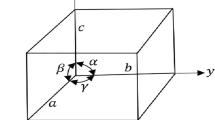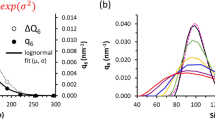Abstract
We correct magic formulas for body centered cubic (bcc) structures. The logical rational for this is further corroborated by calculations of the radial distribution function (RDF) for several crystal structures. We add results for truncated cubes which may be found in nature.
Similar content being viewed by others
Introduction
We recently presented magic formulas for several crystal nanoclusters [1]. However, it is known to crystallographers that bcc structures have a bulk coordination of eight. The RDF determines the nearest neighbor peaks from a central point, and the integrated peak intensity reflects the corresponding coordination for those neighbors. We use an established method [2] to calculate the RDF for several crystals. Since ideal bcc cubes have coordination cn=1, we provide results for truncated bcc and face centered cubic (fcc) clusters.
Main Text
In reviewing the many magic formulas appearing in [1], it occurred to us that equation (1), which defines the adjacency matrix, depends on the crystal structure.
Here, rij is the Euclidean distance between atom i and atom j. While it is true that rc=1.32·rmin is necessary for the different bond lengths in the dodecahedral structure, for the bcc structure, this is not the case. We have calculated [2] the RDF for selected structures, and some of the nearest neighbors are tabulated below (Table 1). The RDF has peak locations at neighbor sites, and the integrated intensity of the corresponding peak gives the coordination. We normalize the peaks in R(r) by dividing by the first peak, thus the peak locations become dimensionless. As the table indicates, bcc structures have \(r_{c} = 2/\sqrt {3} \cdot r_{\text {min}} \approx 1.15 \cdot r_{\text {min}}\), which means the adjacency matrix must be changed, and thus the magic formulas. Note that neighbor peaks are not the same as shells, which give rise to the “magic numbers.” The dodecahedron is a complicated case, where the third neighbors appear at r2=1.31·rmin. This case is challenging, and requires more analysis, which is in progress. The corrected bcc results are shown below (Tables 2, 3, 4, 5 and 6). These results agree with those in van Hardeveld and Hartog [3] if one shifts the index by one, i.e., we use the sequence 0, 1, 2... and they use 1, 2, 3... as their sequence. While perfect cubes may be of interest mathematically, they are not likely to appear in nature, due to single bonds at the corners. We have therefore generated truncated bcc and fcc cubes with the corners removed and their results are included in (Tables 7 and 8). The magic formulas of the indices for selected clusters are summarized in Table 9.
Conclusions
We have corrected magic formulas for bcc structures and added results from the RDF and for truncated bcc and fcc cubes.
Availability of Data and Materials
The dataset(s) supporting the conclusions of this article may be obtained from the corresponding author.
Abbreviations
- bcc:
-
Body centered cubic
- fcc:
-
Face centered cubic
- RDF:
-
Radial distribution function
References
Kaatz FH, Bultheel A (2019) Magic mathematical relationships for nanoclusters. Nanoscale Res Lett 14(1):150.
Juhas P, Farrow CL, Yang X, Knox KR, Billinge SJL (2015) Complex modeling: a strategy and software program for combining multiple information sources to solve ill posed structure and nanostructure inverse problems. Acta Cryst A71:562–568.
van Hardeveld R, Hartog F (1969) The statistics of surface atoms and surface sites on metal clusters. Surf Sci 15:189–230.
Acknowledgements
We made use of the MATLAB file, Cluster Generator, which can be found in Mathworks File Exchange Central.
Funding
The authors did not receive external funding for this work.
Author information
Authors and Affiliations
Contributions
FHK conceived of the project and analysis. AB wrote the code in MATLAB. Both authors contributed to writing the paper and approved the final version of the manuscript.
Corresponding author
Additional information
Publisher’s Note
Springer Nature remains neutral with regard to jurisdictional claims in published maps and institutional affiliations.
Rights and permissions
Open Access This article is distributed under the terms of the Creative Commons Attribution 4.0 International License (http://creativecommons.org/licenses/by/4.0/), which permits unrestricted use, distribution, and reproduction in any medium, provided you give appropriate credit to the original author(s) and the source, provide a link to the Creative Commons license, and indicate if changes were made.
About this article
Cite this article
Kaatz, F.H., Bultheel, A. Magic Mathematical Relationships for Nanoclusters—Errata and Addendum. Nanoscale Res Lett 14, 295 (2019). https://doi.org/10.1186/s11671-019-3115-7
Received:
Accepted:
Published:
DOI: https://doi.org/10.1186/s11671-019-3115-7




